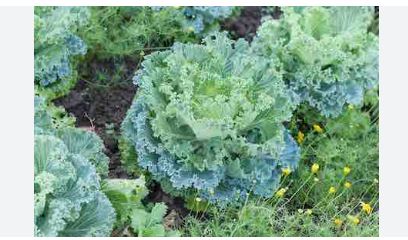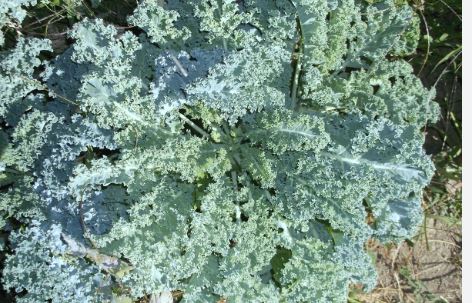
Botanical Classification
Blue Curled Scotch Kale, also known as Vates Kale, is scientifically classified as Brassica oleracea var. acephala, within the Brassicaceae family, which includes cruciferous vegetables like cabbage, broccoli, and collards. The acephala variety denotes non-heading brassicas, grown for their loose, edible leaves rather than forming a compact head.
Vates is a specific cultivar of curly kale, selected for its compact growth and cold tolerance, sharing its genetic lineage with wild cabbage (Brassica oleracea) from the Mediterranean, domesticated for its foliage. Its botanical classification aligns it closely with other kale varieties bred for culinary and nutritional value.
Origin and History
Blue Curled Scotch Kale traces its roots to the eastern Mediterranean and Asia Minor, where kale-like greens were cultivated as early as 2000 BCE by ancient Greeks and Romans. Curly kales became prominent in northern Europe, particularly Scotland, by the Middle Ages, earning the name “Scotch” for their prevalence in Scottish cuisine.
The Vates strain was developed in the early 20th century at the Virginia Truck Experiment Station (hence “Vates”) in the United States, selected for uniformity, compact size, and resistance to bolting and pests. Its reliability made it a staple in American gardens, and its cultivation expanded during the 21st-century superfood trend, with significant production in states like California, Oregon, and New York.
Identifying Characteristics

Blue Curled Scotch Kale is distinguished by its compact, tightly curled, blue-green leaves, which form a dense rosette growing 12-24 inches tall and wide. The leaves are deeply frilled, with a waxy coating that gives them a frosted, bluish hue, enhancing their ornamental appeal. Stems are pale green, edible when young but toughening with age.
Unlike taller kales, Vates has a dwarf, bushy habit, making it ideal for small gardens or containers. Its cold tolerance allows it to maintain vibrant color and texture even after frost, and its pest resistance sets it apart from other curly kales, making it a favorite among growers.
Taste
Blue Curled Scotch Kale has a robust, slightly bitter, and peppery flavor with earthy, nutty undertones, typical of curly kales but milder than wilder varieties. Its texture is crisp and chewy when raw, softening to a savory, cabbage-like taste when cooked. Massaging raw leaves with oil or acid, such as lemon juice, reduces bitterness, making them suitable for salads.
Light frosts enhance sweetness by converting starches to sugars, improving flavor for fall and winter harvests across the U.S., where its bold taste pairs well with strong seasonings and hearty ingredients.
Seasons/Availability
Blue Curled Scotch Kale is a cool-season crop, thriving in temperatures between 7-24°C (45-75°F), with frost tolerance down to -12°C (10°F). In the USA, it’s planted in early spring (February-March) or late summer (July-August), maturing in 50-60 days, and is typically available from late spring (April-May) through early winter (November-December).
It grows well in USDA zones 2-11, with major production in California, Oregon, and New York. Peak flavor occurs in fall after light frosts, and year-round availability is common in U.S. supermarkets due to greenhouse cultivation and imports, sold fresh, as baby leaves, or frozen.
Culinary Uses
Blue Curled Scotch Kale’s hearty texture and bold flavor make it a versatile ingredient in American cuisine. Raw, its leaves are massaged for salads, blending well with citrus dressings, nuts, or cheeses to balance bitterness, popular in health-conscious recipes. It’s a common addition to smoothies, providing nutrients without overpowering flavors.
Cooked, it excels in soups, stews, or stir-fries, holding its structure when sautéed with garlic or olive oil, as seen in Southern greens or Scottish broths. Baking it into crispy kale chips with seasoning is a modern favorite. Young stems are edible, while mature ones can flavor broths, offering zero-waste potential in U.S. dishes.
Nutritional Value
Blue Curled Scotch Kale is a nutrient-dense superfood, low in calories (about 33-35 per cup raw) and packed with vitamins, minerals, and antioxidants. It’s an excellent source of vitamins K, A, and C, providing over 100% of daily needs per serving, supporting blood clotting, vision, and immune health. It contains 2-3 grams of fiber per cup, aiding digestion, and is rich in calcium, iron, and magnesium for bone and blood health.
Antioxidants like quercetin, kaempferol, and glucosinolates offer anti-inflammatory and potential cancer-preventive benefits. Vates also provides folate and omega-3 fatty acids, making it a valuable staple for plant-based, health-conscious diets.
Cultivation of Blue Curled Scotch Kale (Vates Kale)
- Climate and Season: Vates Kale thrives in cool weather, with optimal temperatures between 7-24°C (45-75°F), and tolerates frosts down to -12°C (10°F). Plant in early spring (February-March) or late summer (July-August) for spring and fall harvests. It grows in USDA zones 2-11, with year-round cultivation in mild areas like coastal California and peak fall harvests in colder states like Vermont.
- Site Selection: Choose a site with full sun (6-8 hours daily) to promote vibrant leaf color, though partial shade is tolerated in warmer states like Georgia or Texas to prevent bolting. Ensure good air circulation to minimize fungal diseases, particularly in humid areas like the Southeast.
- Soil Requirements: Prefers fertile, well-drained, loamy soil with a pH of 6.0-7.5. Enrich with organic matter like compost or aged manure. In regions with clay soils (e.g., Midwest) or sandy soils (e.g., Florida), amend with compost to improve drainage and fertility for healthy foliage.
- Soil Preparation: Loosen soil to 12 inches deep, mixing in 2-3 inches of compost or organic matter. Remove rocks and debris to support root development. Conduct a soil test through local extension services (e.g., USDA’s NRCS) to confirm pH and nutrient levels, adjusting with lime or sulfur as needed.
- Planting: Sow seeds ¼-½ inch deep, spacing 12-18 inches apart in rows 18-24 inches apart to accommodate its 12-24 inch growth. Transplant seedlings started indoors 6-8 weeks earlier for faster harvests, common in shorter-season areas like the Northeast. Direct sowing works well in milder regions like California.
- Watering: Maintain consistent soil moisture, providing 1-1.5 inches of water weekly, adjusting for rainfall. Use drip irrigation, popular in arid states like Arizona, to keep leaves dry and reduce disease risk. Mulch to retain moisture, especially in hot, dry regions like the Southwest.
- Fertilization: Apply a balanced fertilizer (e.g., 10-10-10) at planting, followed by a nitrogen-rich fertilizer (e.g., fish emulsion) every 4-6 weeks to encourage leafy growth. Avoid over-fertilizing, which can attract pests in humid areas like the Gulf Coast and affect flavor quality.
- Mulching: Add a 2-3 inch layer of organic mulch, such as straw or wood chips, to conserve moisture, suppress weeds, and keep roots cool. This is critical in regions with temperature swings, like the Midwest, or hot summers, like the Southeast, to stabilize soil conditions.
- Pest Management: Monitor for pests like aphids, cabbage worms, and flea beetles, though Vates is more pest-resistant than other kales. Use floating row covers in organic farms (e.g., Oregon), neem oil, or introduce beneficial insects like ladybugs, popular in California. Hand-pick caterpillars for small gardens, effective nationwide.
- Disease Control: Prevent fungal diseases like powdery mildew and black rot, prevalent in humid regions like the Southeast, by ensuring air circulation and avoiding overhead watering. Rotate crops every 2-3 years, standard in intensive farming states like California, to reduce soil-borne pathogens.
- Harvesting: Harvest outer leaves when 6-8 inches long, about 50-60 days after planting, cutting close to the stem to encourage regrowth. Start in late spring (April-May) or fall (September-November), with sweeter leaves post-frost in colder states like New York. Regular harvesting extends yield through the season.
- Succession Planting: Sow seeds every 2-3 weeks in spring or fall for a continuous supply, a common practice in mild climates like California’s Central Valley. In shorter-season regions like Minnesota, focus on spring and late summer plantings to maximize harvests before hard freezes.
- Storage and Preservation: Store fresh Vates Kale at 0-4°C (32-40°F) in a perforated plastic bag in the refrigerator for up to 2-3 weeks, standard for U.S. households. For long-term storage, blanch leaves for 2-3 minutes, cool in ice water, dry thoroughly, and freeze to preserve nutrients. Wash and dry before storing to maintain freshness.